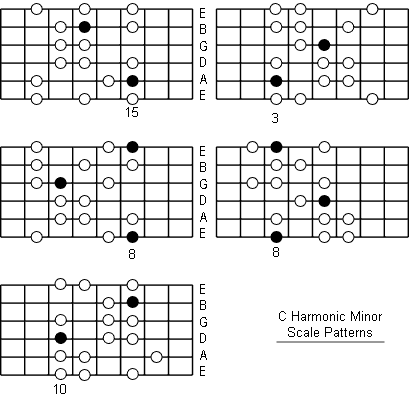
Note: when we say “played on top of the V7 chord” it means that it is the harmonic minor scale of the first degree (Im7), only played when the V7 chord appears. Notice that in the “V7 – Im7” resolution, the harmonic minor scale is played on top of the V7 chord, as this chord characterizes the harmonic minor tonality.
#C harmonic minor scale how to
We will show you some examples of how to use this scale. In addition, the dominant V7 is very easy to identify with the ear, especially in a context of a minor tonality. This is very important to know, as this is the chord progression that appears most in the songs when the subject is harmonic minor. Therefore, the “V7 – Im7” resolution is typical of the minor key. And in the minor key there is no V7, because the fifth degree is minor (Vm7): In the major key, the V7 resolves in a major chord, as we already know. This resolution is typical of the harmonic minor context, as it does not exist in the natural major key or the natural minor. The context in which the harmonic minor scale most often appears in solos, riffs or arrangements is when a V7 chord resolves in a minor chord. The easiest way to discover the context in which you can use this scale is to pay attention to the fifth degree, as we will explain below. Thankfully, in practice, as we already mentioned in the article “ How and where to apply scales“, you will hardly apply this scale thinking about the key in this way. This makes our life a little difficult, because we would always need to be paying attention to the corresponding degrees and tonalities to know when we can and when we cannot apply the harmonic minor scale. However, if the song were in G major and the Em7 chord appeared, it would be the sixth degree (VIm7) that belongs to the major key, that is, it would not allow the use of the harmonic B minor scale over it (generically speaking). In this case, to use this scale on top of these chords, you would need to identify, for example, if the chord with the extension m7, let’s say Em7, is the fourth degree of the song (IVm7) as we see in the shape for this progression:įor that, the song would need to be in B minor, so you could play the harmonic B minor scale at the time that this Em7 chord appears, because the associated key would be: The problem is that, in practice, the chords Im(M7), IIImaj7(#5) rarely appear, and the other chords with the extensions m7(b5), m7, 7, maj7, appear in numerous contexts, which makes the approach difficult, because it may be that these chords belong to another key that is not the harmonic minor. Great, so theoretically whenever we identify one of these chords/degrees in a song, we can apply the harmonic minor scale to our solo, since the harmony allows for this. More generally, the harmonic minor chords can be seen as follows: We will not do this whole procedure again so as not to get boring. The only difference is that the scale used here was the harmonic minor scale. Note: the method we use to form this chords is the same that we used to form the chords of the major key from the major scale. The chords of the key generated by the A minor harmonic scale is as follows: Notice how this scale alone already has a pleasant flavor. Try playing this scale repeatedly to feel the melody.


See the shape of the harmonic minor scale of A (the seventh major degree is highlighted in red) below: A harmonic minor scale: This change provided a very interesting sound. This seventh major degree on the minor harmonic scale increased the distance between degrees 6 and 7, shortening the distance between degrees 7 and 8. Notice how the only difference is in the seventh degree (in this case, the G note).


 0 kommentar(er)
0 kommentar(er)
